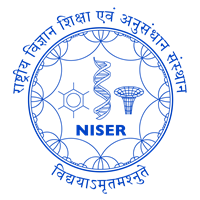

Reader - F
Chairperson SEPS
litonniser.ac.in
+91-674-2494028 / 2482
Star and Planet Formation, Molecular Astrophysics/Astrochemistry, Exoplanets and their atmospheres
Publications (after joining NISER as a Faculty)
29. Chemical Compositions in the Vicinity of Protostars in Ophiuchus
K. Taniguchi, L. Majumdar*, A. Plunkett, S. Takakuwa, D. C. Lis, P. F. Goldsmith, F. Nakamura, M. Saito, E. Herbst
ApJ 922, 152 (2021)
28. Detectable Abundance of Cyanoacetylene (HC3N) Predicted on Reduced Nitrogen-rich Super-Earth Atmospheres
Paul B. Rimmer, L. Majumdar, A. Priyadarshi, S. Wright, S. N. Yurchenko
ApJ 921, L28 (2021)
27. An unbiased NOEMA 2.6 to 4 mm survey of the GG Tau ring: First detection of CCS in a protoplanetary disk
N. T. Phuong, A. Dutrey, E. Chapillon, S. Guilloteau, J. Bary, T. L. Beck, A. Coutens, O. Denis-Alpizar, E. Di Folco, P. N. Diep, L. Majumdar, J. -P. Melisse, C. -W. Lee, V. Pietu, T. Stoecklin, Y. -W. Tang
A&A 653, L5 (2021)
26. Evolutionary view through the starless cores in Taurus: Deuteration in TMC 1-C and TMC 1-CP
D. Navarro-Almaida1, A. Fuente, L. Majumdar, V. Wakelam, P. Caselli, P. Rivière-Marichalar, S. P. Treviño-Morales, S. Cazaux, I. Jiménez-Serra, C. Kramer, A. Chacón-Tanarro, J. M. Kirk, D. Ward-Thompson, and M. Tafalla
A&A 25, A15 (2021)
25. Probing Polarization and the Role of Magnetic Fields in Cloud Destruction in the Keyhole Nebula
Y. Seo, D. C. Dowell, P. F. Goldsmith, J. L. Pineda, L. Majumdar
ApJ 917, 57 (2021)
24. Carbon-chain Chemistry versus Complex-organic-molecule Chemistry in Envelopes around Three Low-mass Young Stellar Objects in the Perseus Region
K. Taniguchi, L. Majumdar*, S. Takakuwa, M. Saito, D. C. Lis, P. F. Goldsmith, E. Herbst
ApJ 910, 141 (2021)
23. A New Method for Simulating Photoprocesses in Astrochemical Models
E. Mullikin, H. Anderson, N. O'Hern, M. Farrah, C. R. Arumainayagam, E. F. van Dishoeck, P. A. Gerakines, A. I. Vasyunin, L. Majumdar, P. Caselli, C. N. Shingledecker
ApJ 910, 72 (2021)
22. Chemical compositions of five Planck cold clumps
V. Wakelam, P. Gratier, M. Ruaud, R. Le Gal, L. Majumdar, J.-C. Loison, K. M. Hickson
A&A 28, A172 (2021)
21. Carbon Chain Chemistry in Hot-core Regions around Three Massive Young Stellar Objects Associated with 6.7 GHz Methanol Masers
K. Taniguchi, E. Herbst, L. Majumdar, P. Caselli, J. Tan, Z. Li, T. Shimoikura, K. Dobashi, F. Nakamura, M. Saito
ApJ 908, 100 (2021)
20. Possibility of concentration of nonvolatile species near the surface of comet 67P/Churyumov-Gerasimenko
T. Suzuki, Y. Shinnaka, L. Majumdar*, T. Shibata, Y. Shibaike, H. Nomura, H. Minamoto
A&A 645, A134 (2021)
19. Exocomets from a Solar System Perspective
P. A. Strøm, D. Bodewits, M. M. Knight, F. Kiefer, G. H. Jones, Q. Kral, L. Matrà , E. Bodman, M. T. Capria11, I. Cleeves, A. Fitzsimmons, N. Haghighipour, J. H. D. Harrison, D. Iglesias, M. Kama, H. Linnartz, L. Majumdar, E. J. W. de Mooij, S. N. Milam, C. Opitom, I. Rebollido, L. K. Rogers, C. Snodgrass, C. Sousa-Silva, S. Xu, Z. Lin, and S. Zieba
PASP 132, 101001 (2020)
18. Isomers in Interstellar Environments. I. : The Case of Z- and E-Cynaomethanimine
C. N. Shingledecker, G. Molpeceres, V. M. Rivilla, L. Majumdar, J. Kastner
ApJ 897, 158 (2020)
17. Chemical composition in the IRAS 16562–3959 high-mass star-forming regions
K. Taniguchi, A. Guzman, L. Majumdar, M. Saito, K. Tokuda
ApJ 898, 54 (2020)
16. Planet-induced spirals in the circumbinary disk of GG Tauri A
N. T. Phuong, A. Dutrey, E. Di Folco, S. Guilloteau, A. Pierens, J. Bary, T. L. Beck, E. Chapillon, O. Denis-Alpizar, P. N. Diep, L. Majumdar, V. Pietu, Y. -W. Tang
A&A 635, L9 (2020)
Publications (as an independent Postdoc):
15. Protoplanetary disks: Sensitivity of the chemical composition to various model parameters
V. Wakelam, E. Chapillon, A. Dutrey, S. Guiloteau, W. Iqbal, A. Coutens, L. Majumdar
MNRAS 486, 1563 (2019)
14. An Ammonia Spectral Map of the L1495-B218 Filaments in the Taurus Molecular Cloud: II CCS & HC7N Chemistry and Three Modes of Star Formation in the Filaments
Y. Seo, L. Majumdar, P. F. Goldsmith, Y. L. Shirley, K. Willacy, D. Ward-Thompson, R. Friesen et al.
ApJ 871, 134 (2019)
13. Detection of HOCO+ in the protostar IRAS 16293-2422
L. Majumdar*, P. Gratier, V. Wakelam, E. Caux, K. Willacy, M. E. Ressler
MNRAS 477, 525 (2018)
12. Methyl isocyanate CH3NCO: An important missing organic in current astrochemical networks
L. Majumdar*, J. C. Loison, M. Ruaud, P. Gratier, V.Wakelam, A. Coutens
MNRAS Letters 473, L59 (2018)
11. Methyl cyanide (CH3CN) and propyne (CH3CCH) in the low mass protostar IRAS 16293-2422
I. Andron, P. Gratier, L. Majumdar, T. Vidal, A. Coutens, J. C. Loison, V. Wakelam,
MNRAS 481, 5651 (2018)
10. Chemical Diversity in Three Massive Young Stellar Objects Associated with 6.7 GHz CH3OH Masers
K. Taniguchi, M. Saito, L. Majumdar, T. Shimoikura, K. Dobashi, H. Ozeki, F. Nakamura, T. Hirota, T. Minamidani, Y. Miyamoto, H. Kaneko
ApJ 866, 150 (2018)
9. An expanded gas-grain model for interstellar glycine
T. Suzuki, L. Majumdar*, M. Ohishi, M. Saito, T. Hirota, V. Wakelam
ApJ 863, 51 (2018)
8. The difference in abundance between N-bearing and O-bearing species in highmass star forming regions
T. Suzuki, M. Ohishi, M. Saito, T. Hirota, L. Majumdar*, V. Wakelam
ApJs 237, 42 (2018)
7. The first detection of H2S in protoplanetary disk: The dense GG Tau A ring
N. T. Phuong, E. Chapillon, L. Majumdar, S. Guilloteau, V. Pietu, V. Wakelam, P. N. Diep, T. Beck, J. Barry
A&A 616, L5 (2018)
6. Chemistry of TMC-1 with multiply deuterated species and spin chemistry of H2, H2+, H3+ and their isotopologues
L. Majumdar*, P. Gratier, M. Ruaud, V. Wakelam, C. Vastel, O. Sipila, F. Hersant, A. Dutrey, S. Guolloteau
MNRAS 466, 4470 (2017)
5. A study of singly deuterated cyclopropenylidene c-C3HD in protostar IRAS 16293-2422
L. Majumdar*, P. Gratier, I. Andron, V. Wakelam, E. Caux
MNRAS 467, 3525 (2017)
4. Detection of CH3SH in protostar IRAS 16293-2422
L. Majumdar*, P. Gratier, T. Vidal, V. Wakelam, J. C. Loison, K. M. Hickson, E. Caux
MNRAS 458, 1859 (2016)
3. A new reference chemical composition for TMC-1
P. Gratier, L. Majumdar, M. Ohishi, E. Roueff, J. C. Loison, K. M. Hickson, V. Wakelam
ApJs 225, 25 (2016)
2. Survey observation of a possible Glycine Precursor Methanimine CH2NH
T. Suzuki, M. Ohishi, T. Hirota, M. Saito, L. Majumdar, V. Wakelam
ApJ 825, 79 (2016)
1. Importance of the H2 abundance in protoplanetary disk ices for the molecular layer chemical composition
V. Wakelam, M. Ruaud, F. Hersant, A. Dutrey, D. Semenov, L. Majumdar, S. Guolloteau
A&A 594, A35 (2016)
My research interests are at the interfaces of Astrophysics, Molecular Astrophysics/Astrochemistry and Exoplanetary Science- mostly focussed on understanding the physical and chemical origins of planetary systems such as our own. Right now, I am mostly working on some of the unique fundamental questions about star formation, planetary formation, exoplanets and their atmospheres:
(a) What physical processes play a role in the formation of stars?
(b) How do planets and planetary systems form?
(c) What is the chemical evolution of interstellar material on its voyage from clouds to forming stars and ultimately to newborn planets? How common are the ingredients for life such as water, and do they naturally evolve as part of new planets?
(d) What is the inventory of organics and water in regions of planet formation, particularly in the habitable zone? Did delivery of exogenous organics and water enable the emergence and evolution of life? In short: Why is Earth wet and alive?
(e) How can we watch other solar systems form? What does the composition of the Earth and other Solar System objects tell us about how they formed?
(f) How do planets and their atmospheres evolve over time? What are exoplanets made of?
(g) Can we find evidence for habitability elsewhere in the present day Solar System, and habitable environments in extra-solar planets? Would this evidence inform the delivery of exogenous prebiotic matter to Earth?
(h) How many Earth-like planets exist? Do they have atmospheres? In other words, is Earth unique?